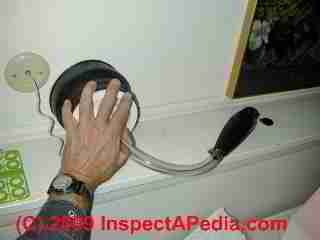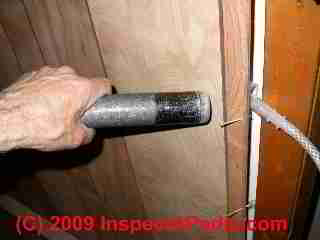 Vacuuming Building Cavities to Screen for Hidden Mold: Guide to Good Practices
Vacuuming Building Cavities to Screen for Hidden Mold: Guide to Good Practices
- POST a QUESTION or COMMENT about vacuuming building cavities to screen for dust or mold hazards
Guide to vacuuming building cavities to screen for particles, dust, or mold:
This article explains the advantages and shortcomings of using vacuum cassettes or spore traps to collect mold test samples (or other dust or particle samples) from building wall and ceiling cavities.
In this article series discuss the validity of nearly all of the popular mold testing methods currently in use, pointing out the strengths and weakness of each approach to mold sampling in the indoor environment, beginning with air sampling for airborne mold levels indoors.
InspectAPedia tolerates no conflicts of interest. We have no relationship with advertisers, products, or services discussed at this website.
- Daniel Friedman, Publisher/Editor/Author - See WHO ARE WE?
Validity/Accuracy of Vacuuming Building Cavities for a Hidden Mold Screen
15th Annual North Carolina/South Carolina
Environmental Information Association Technical Conference
Myrtle Beach, SC
Daniel Friedman 23 September 2005, Updated 4/14/2009 & 27 March 2024
Vacuuming building cavities is a popular screening practice to look for mold reservoirs. The investigator is trying to explore wall cavities while doing minimal or no visible damage.
A wall-check™ system has been marketed for this purpose and several manufacturers have coped the basic idea: a receiving Air-o-Cel™ or MCE filter cassette is attached at its inlet side to a tube which is inserted as a probe into a wall cavity, permitting creation of only a small hole.
The outlet or pump side of the test device is connected to a pump and operated, typically at 15 lpm.
Where we have tested this method we have experimented with both passive collection (what most investigators use) or aggressive collection (banging on the wall/ceiling at various points to attempt to dislodge and stir particles).
Short duration samples, 1-2 minutes using an Air-o-Cell ™ permit a comparatively large number of samples to be collected in a reasonably short interval. Long duration samples, perhaps for up to two hours, are collected using an MCE filter cassette.
Wall Cavity Vacuuming - Found Ineffective
Working with Louis Relle, a Louisiana mold remediation expert on a New
Orleans Building which was to be demolished we collected wall-check samples from every suspect Building cavity.
When the
building interior surfaces were demolished we then performed a visual inspection and collected bulk surface samples using tape.
See DUST / MOLD TEST KIT INSTRUCTIONS
The wall check samples were
completely unable to detect large and significant mold contamination in the cavities of this building.
We postulate that
even with mechanical agitation (banging on the wall during wall check sampling) the flow rate of the sampling method does
not move enough air to reliably pick up surface contamination unless the mold genera/species happens to be at a
particularly high state of active sporulation. The tool remains in the professional's arsenal, to be used with
discretion.
Shortcomings of vacuuming building cavities through a tube but our testing strongly suggests that this method is very unreliable for characterizing wall contents.
We do not believe that enough air movement is created in the wall cavity (sucking any lpm flow through a small diameter tube) to reliably collect what could be a severe mold reservoir that happens not to be right next to the probe. Further if the cavity is insulated there will be virtually no air or particle movement except from very close to the probe.
What should we make of wall vacuum test results done without other inspection and testing?
Wall cavity vacuum tests, depending on how and when they are performed, can be like searching for a needle in a haystack while looking through a straw: if you find evidence of a problem you're lucky. But if you don't find evidence, when using a very limited-scope method, that doesn't mean that a problem is not there.
Our photo, left, is not showing the wall-check vacuum method that relies on vacuuming into a cassette through a hole in the wall. Instead, here we have pulled loose paneling and have inserted our spore trap cassette into the cavity.
This position combined with aggressive sampling by banging on the wall paneling with a flashlight is more likely to collect problem particles if they are present close to the point of vacuum cassette insertion into the wall. But even this approach is not a reliable characterization of mold risk in the building.
And it is not looking into the wall cavity itself - rather we are looking at the two surfaces behind the paneling.
Short vacuum pump duration for microscopic examination (to avoid sample overload, e.g. 2-=3 minutes on an Air-O-Cell) does not move enough air to reliably find what may be in the wall cavity.
An experiment done with Louis Relle in New Orleans LA demonstrated that wall-vac tests found less than 10% of large problem mold cavities that could be discovered by cutting drywall openings in a building.
Our photo (left) shows a short-duration but larger surface area or wall opening vacuuming system invented and tested by the author - it did not provide useful results.
Longer vacuum pump duration samples for viable sampling (2 hours into an MCE cassette for culturing) still may not move enough air to sample through a cavity, particularly if the cavity is insulated. Further, two-hour samples means that most-likely very few sample points were collected, making the inspection scope extremely limited and thus overall confidence in the accuracy of the picture of the building lower.
Consider that the popularly-marketed version of this wall cavity vacuuming approach to test for hidden mold contamination in buildings relies on culture of the sample. Did you know that only about 10% of molds grow in any culture at all? You're 90% uncertain of the accuracy of the test at the outset.
One can't be sure that the mold that grew in the culture represents the dominant problem mold or whether it's just a low-occurrence (in the building) spore that liked the media (in the culture). We like cultures for further genera/species identification of samples but we are nervous about relying on them to tell me if the building has a problem or not.
Because mold test validity and mold test accuracy are often confused, readers should also
see ACCURACY OF AIR TESTS for MOLD.
...
Continue reading at VACUUM TEST INSULATION CONTAMINANTS or select a topic from the closely-related articles below, or see the complete ARTICLE INDEX.
Or see these
Recommended Articles
- DUST SAMPLING PROCEDURE
- INDOOR AIR QUALITY METHODS COMPARED
- MOLD TEST PROCEDURES
- TECHNICAL & LAB PROCEDURES
- MOLD / ENVIRONMENTAL EXPERT, HIRE ?
- VACUUMING BUILDING CAVITIES
- VACUUM CASSETTE FILTER SAMPLE TESTS for DUST / MOLD
- VACUUM SAMPLING EQUIPMENT, DIY
- VACUUM TEST INSULATION CONTAMINANTS
Suggested citation for this web page
VACUUMING BUILDING CAVITIES at InspectApedia.com - online encyclopedia of building & environmental inspection, testing, diagnosis, repair, & problem prevention advice.
Or see this
INDEX to RELATED ARTICLES: ARTICLE INDEX to BUILDING ENVIRONMENT
Or use the SEARCH BOX found below to Ask a Question or Search InspectApedia
Or see
INDEX to RELATED ARTICLES: ARTICLE INDEX to MOLD CONTAMINATION & REMEDIATION
Or use the SEARCH BOX found below to Ask a Question or Search InspectApedia
Ask a Question or Search InspectApedia
Try the search box just below, or if you prefer, post a question or comment in the Comments box below and we will respond promptly.
Search the InspectApedia website
Note: appearance of your Comment below may be delayed: if your comment contains an image, photograph, web link, or text that looks to the software as if it might be a web link, your posting will appear after it has been approved by a moderator. Apologies for the delay.
Only one image can be added per comment but you can post as many comments, and therefore images, as you like.
You will not receive a notification when a response to your question has been posted.
Please bookmark this page to make it easy for you to check back for our response.
IF above you see "Comment Form is loading comments..." then COMMENT BOX - countable.ca / bawkbox.com IS NOT WORKING.
In any case you are welcome to send an email directly to us at InspectApedia.com at editor@inspectApedia.com
We'll reply to you directly. Please help us help you by noting, in your email, the URL of the InspectApedia page where you wanted to comment.
Citations & References
In addition to any citations in the article above, a full list is available on request.
- In addition to citations & references found in this article, see the research citations given at the end of the related articles found at our suggested
CONTINUE READING or RECOMMENDED ARTICLES.
- Carson, Dunlop & Associates Ltd., 120 Carlton Street Suite 407, Toronto ON M5A 4K2. Tel: (416) 964-9415 1-800-268-7070 Email: info@carsondunlop.com. Alan Carson is a past president of ASHI, the American Society of Home Inspectors.
Thanks to Alan Carson and Bob Dunlop, for permission for InspectAPedia to use text excerpts from The HOME REFERENCE BOOK - the Encyclopedia of Homes and to use illustrations from The ILLUSTRATED HOME .
Carson Dunlop Associates provides extensive home inspection education and report writing material. In gratitude we provide links to tsome Carson Dunlop Associates products and services.


